Shock of the old: 10 agonising and awful contraceptives
TThe more I think about birth control, the angrier I get, which is absolutely the ideal state to put together a light-hearted review of its most remarkable visual history. But it’s all so unfair! Thousands of years of mansplaining, hypocrisy and manufactured moral outrage, resulting in a desperate tale of death, injury, pain and poverty. It’s enough to put anyone in a terrible mood, and my exploratory research has turned up images I wouldn’t wish on my worst enemy. (Etsy chastity belts, I’m looking at you. Well, I’m not looking at you now and I wish I never had.)
Naturally, people tried everything they could think of to prevent pregnancy, even before they had the slightest idea how it happened. There were things you consumed “blacksmith water” – wonderfully enriched with lead equally toxic mercury. The Romans loved silphiuma now extinct relative of giant fennel, so much so that it was celebrated on coinswhile Pennyroyal was recommended by the ancient Greek physician Dioscorides and still sold as “help for ladies” until the 20th century.
Emetics to ‘purify the desire for intercourse’ were popular in Elizabethan times (and yes, if you made me drink “radish root, agarick and saram boiled in barley water” that would probably be the solution). The pessaries might have been less likely to kill you, but my God, they sound uncomfortable: cabbage or elephant dung? What is the Farsi for ‘thrush’?
Before the advent of vulcanized rubber condoms in the 1850s, the efforts of pioneers in family planning Margaret Sanger And Marie Stopes and the approval of the pill in the late 1950s, things remained dire. And it wasn’t just women who suffered from the misery of early birth control. The Elizabethans recommended anointing the penis with “rock salt, tar, balsam, oil with white lead, sweet oil, juice of onion, balsam and sesame oil” and genital baths of ginger and vinegar, which sound quite painful and are more like marinades than contraceptives. In the 17th century, the second Earl of Rochester wrote a poem about it how great condoms (“cundums”) weresubsequently died of a sexually transmitted disease.
As for that cheerful touch, why not treat yourself to something nice beaver testicle tea (a Canadian contraceptive) and check out some photos from the bad old days. I think they may be the best contraceptive of all: they definitely shut down what was left of my reproductive facilities for good.
No, it’s not a real contraceptive (although I’ve seen worse pessaries than crumpled papyrus), but this ancient Egyptian medical text takes women’s complaints much more seriously than some doctors I’ve met. I especially enjoy the part where doctors are advised that if a woman complains of “pain in her molars, her front, and her ears,” you should tell her they are “horrors of the womb.” Horrors of the womb! The next time I have to self-certify a medical absence, I will fill it out. Anyway, the suggestions to prevent pregnancy are chopped crocodile dung or a drizzle of honey. Hard choice.
Casanova blows up a condom, 1754
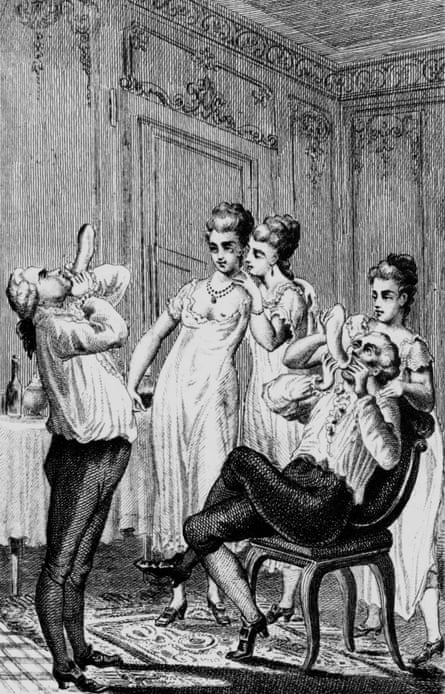
In addition to the condom that self-proclaimed superlover Giacomo Casanova is hanging out with, his memoirs mention the use of a hollowed-out half lemon as a diaphragm. Recent research suggests Lemon juice has some spermicidal properties, but Casanova must have had the pheromonal power of Pete Davidson to entice any right-thinking woman to do so.
Sheep intestine condom, circa 1800
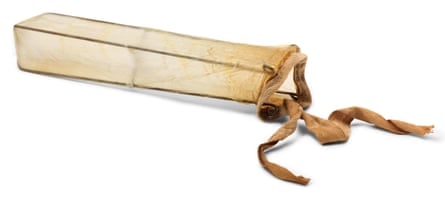
I’d say there’s an ounce of justice in the hideous texture and general disgustingness of historical condoms – fish bladder, linen, sheep intestine, leather – but the person being penetrated suffers as much as the wearer, so that’s not the case. That is the historical condom that bothers me the most the Japanese turtle model that just covered the glans. Wouldn’t you lose it? And don’t forget to wash your condom in warm milk, as the manual says a 17th century Swedish condom instructed.
Chastity belt, 19th century
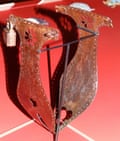
Guess what: chastity belts probably never existed. The medievalist Dr. Albrecht Classen wrote a book explaining that the concept arose from misinterpretations of allegorical or satirical text references. The British Museum example is captioned ‘forgery’ and the accompanying text states that most were ‘made in the 18th and 19th centuries as curiosities for the prurient, or as jokes for the tawdry’. The cute hole you can poop through is a nice touch that unfortunately hasn’t gone unnoticed by Etsy’s weirdest artisans.
Stork card, early 20th century
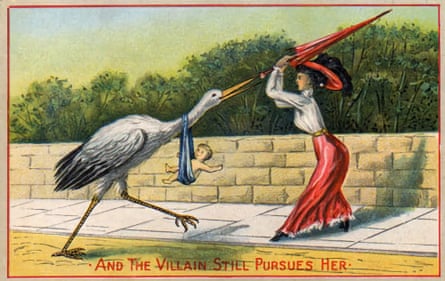
The best method of contraception is abstinence (according to the 18th century Presbyterian elder living in my head) – and what better deterrent than this postcard reimagining the stork as a vengeful nightmare bird? Oh look, here come the nasty consequences of your actions. The beak on! Imagining this near your reproductive parts would certainly have the desired effect.
Omega Spray vaginal douche, 1900-40
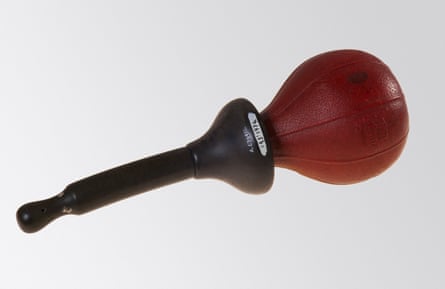
I understand why the principle of the shower seemed right – something went wrong; let’s try to flush it out – but semen is smarter (and faster) than that. Showers were popular, despite being effectively useless, from the 16th century (Pope Sixtus V stated that they used one). a sin worthy of excommunication in 1588) to the folkloric Coca-Cola variant from the 1950s. (Fun fact: researchers discovered this in 2008 Diet Coke kills a lot more sperm than the usual stuff.) Argh! Your pH balance!
Robbery at a birth control club, 1936
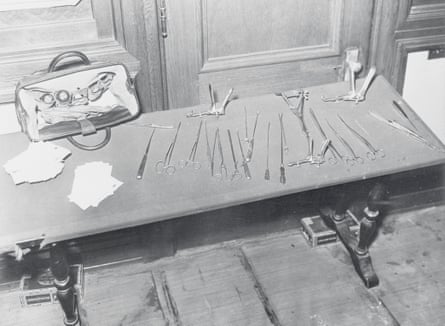
In 1873, the US effectively criminalized contraception through the Comstock Act by categorizing contraceptives as obscene materials. (Anti-abortion activists are now trying to use the law to ban the morning-after pill.) Until Griswold v. Connecticut upheld a constitutional right to contraception in 1965, women were forced to resort to groups like this New Jersey “birth control club”, where they paid $2 a month (about $45 today) in “insurance” – which presumably meant they could get an abortion if they needed one. The photo shows instruments seized during the raid.
Urethral stopper, circa 1920
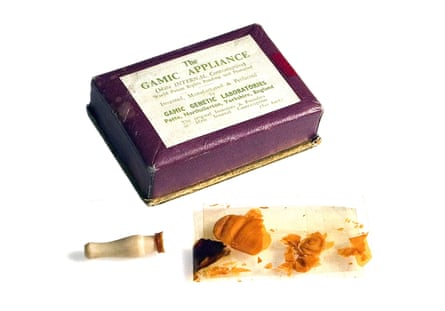
This is one of the worst of the bunch, described by its manufacturer, Gamic Genetic Laboratories of Northallerton in North Yorkshire, as “the first internal contraceptive for men”, created “after years of painstaking research”. Pain, yes, I bet. It was condemned as “completely dangerous and absurd” by Stopes in her 1923 book on contraception.
Stampessaria, 19th century
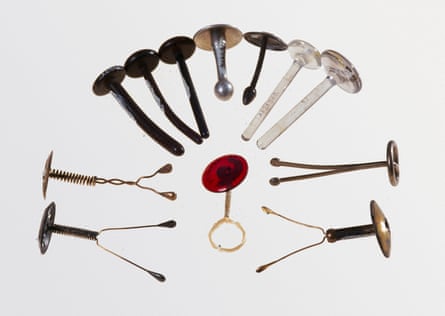
I really don’t like the look of this, a German precursor to the modern IUD that hung around until the 1940s. How big are they? (Huge – about 15cm x 2cm, according to the Smithsonian.) Why do they look like mushrooms? (Apparently the head of the mushroom was against the vaginal wall and the little pieces went into the uterus.) An absolutely sinister affair – just like inserting IUDs these days, amirite?
Gynodate, 1958
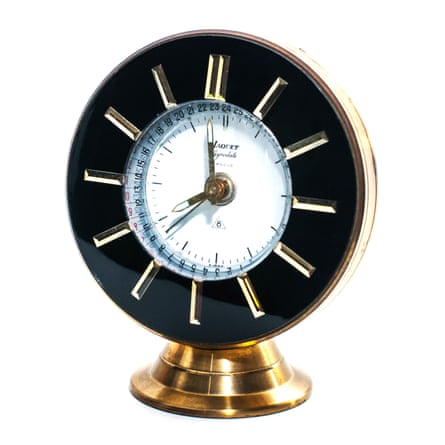
This adorably discreet fertility tracker made by the Swiss clockmaker Jaquet doubled as a bedside table. In addition to the time, fertile and infertile days in the menstrual cycle were displayed, plus the date of ovulation. Is this the most effective contraceptive? Certainly not. The fanciest? Absolute.
